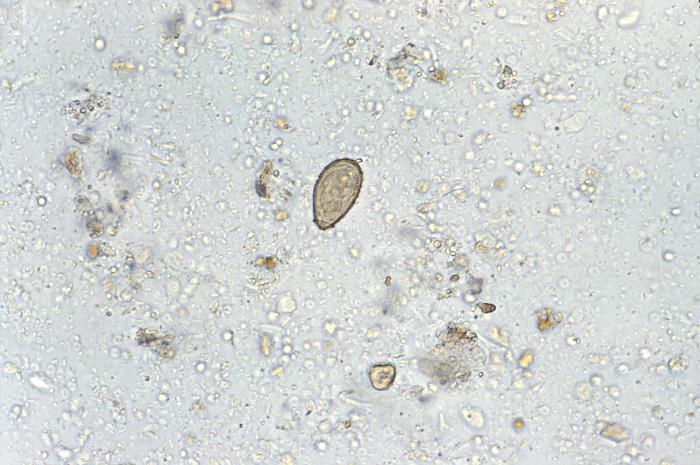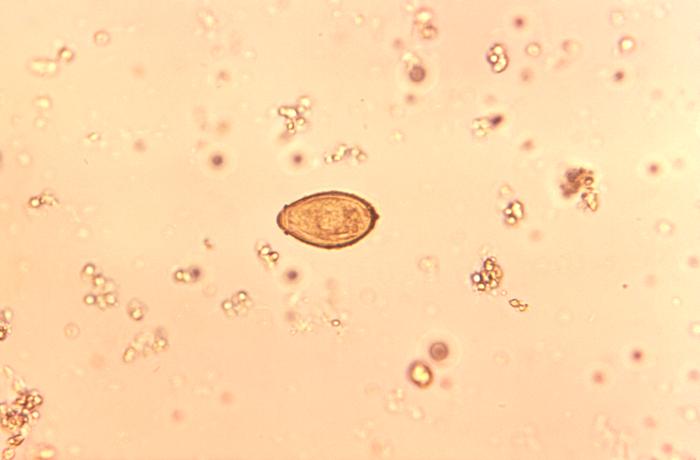[1]
Hong ST, Fang Y. Clonorchis sinensis and clonorchiasis, an update. Parasitology international. 2012 Mar:61(1):17-24. doi: 10.1016/j.parint.2011.06.007. Epub 2011 Jun 30
[PubMed PMID: 21741496]
[2]
Qian MB, Chen YD, Yan F. Time to tackle clonorchiasis in China. Infectious diseases of poverty. 2013 Feb 19:2(1):4. doi: 10.1186/2049-9957-2-4. Epub 2013 Feb 19
[PubMed PMID: 23849773]
Level 2 (mid-level) evidence
[3]
Kim TS, Pak JH, Kim JB, Bahk YY. Clonorchis sinensis, an oriental liver fluke, as a human biological agent of cholangiocarcinoma: a brief review. BMB reports. 2016 Nov:49(11):590-597
[PubMed PMID: 27418285]
[4]
Yoshida Y, Clonorchiasis--a historical review of contributions of Japanese parasitologists. Parasitology international. 2012 Mar;
[PubMed PMID: 21749930]
[5]
. Control of foodborne trematode infections. Report of a WHO Study Group. World Health Organization technical report series. 1995:849():1-157
[PubMed PMID: 7740791]
[6]
Qian MB, Utzinger J, Keiser J, Zhou XN. Clonorchiasis. Lancet (London, England). 2016 Feb 20:387(10020):800-10. doi: 10.1016/S0140-6736(15)60313-0. Epub 2015 Aug 21
[PubMed PMID: 26299184]
Level 2 (mid-level) evidence
[7]
Fürst T, Keiser J, Utzinger J. Global burden of human food-borne trematodiasis: a systematic review and meta-analysis. The Lancet. Infectious diseases. 2012 Mar:12(3):210-21. doi: 10.1016/S1473-3099(11)70294-8. Epub 2011 Nov 20
[PubMed PMID: 22108757]
Level 1 (high-level) evidence
[8]
Qian MB,Chen YD,Liang S,Yang GJ,Zhou XN, The global epidemiology of clonorchiasis and its relation with cholangiocarcinoma. Infectious diseases of poverty. 2012 Oct 25;
[PubMed PMID: 23849183]
Level 2 (mid-level) evidence
[9]
Sripa B. Concerted action is needed to tackle liver fluke infections in Asia. PLoS neglected tropical diseases. 2008 May 28:2(5):e232. doi: 10.1371/journal.pntd.0000232. Epub 2008 May 28
[PubMed PMID: 18509525]
[10]
Fang YY, Chen YD, Li XM, Wu J, Zhang QM, Ruan CW. [Current prevalence of Clonorchis sinensis infection in endemic areas of China]. Zhongguo ji sheng chong xue yu ji sheng chong bing za zhi = Chinese journal of parasitology & parasitic diseases. 2008 Apr:26(2):99-103, 109
[PubMed PMID: 24812810]
[11]
Wang KX, Zhang RB, Cui YB, Tian Y, Cai R, Li CP. Clinical and epidemiological features of patients with clonorchiasis. World journal of gastroenterology. 2004 Feb 1:10(3):446-8
[PubMed PMID: 14760777]
Level 2 (mid-level) evidence
[12]
Qian MB,Zhuang SF,Zhu SQ,Deng XM,Li ZX,Zhou XN, Epidemiology and determinants of clonorchiasis in school children in southeastern China. Acta tropica. 2021 Apr;
[PubMed PMID: 33188749]
Level 2 (mid-level) evidence
[13]
Qian MB, Chen YD, Fang YY, Tan T, Zhu TJ, Zhou CH, Wang GF, Xu LQ, Zhou XN. Epidemiological profile of Clonorchis sinensis infection in one community, Guangdong, People's Republic of China. Parasites & vectors. 2013 Jul 1:6():194. doi: 10.1186/1756-3305-6-194. Epub 2013 Jul 1
[PubMed PMID: 23816055]
Level 2 (mid-level) evidence
[14]
Na BK, Pak JH, Hong SJ. Clonorchis sinensis and clonorchiasis. Acta tropica. 2020 Mar:203():105309. doi: 10.1016/j.actatropica.2019.105309. Epub 2019 Dec 17
[PubMed PMID: 31862466]
[15]
Bouvard V, Baan R, Straif K, Grosse Y, Secretan B, El Ghissassi F, Benbrahim-Tallaa L, Guha N, Freeman C, Galichet L, Cogliano V, WHO International Agency for Research on Cancer Monograph Working Group. A review of human carcinogens--Part B: biological agents. The Lancet. Oncology. 2009 Apr:10(4):321-2
[PubMed PMID: 19350698]
[16]
Zheng M,Hu K,Liu W,Hu X,Hu F,Huang L,Wang P,Hu Y,Huang Y,Li W,Liang C,Yin X,He Q,Yu X, Proteomic analysis of excretory secretory products from Clonorchis sinensis adult worms: molecular characterization and serological reactivity of a excretory-secretory antigen-fructose-1,6-bisphosphatase. Parasitology research. 2011 Sep;
[PubMed PMID: 21424807]
[17]
Qian MB, Zhou XN. Clonorchis sinensis. Trends in parasitology. 2021 Nov:37(11):1014-1015. doi: 10.1016/j.pt.2021.05.011. Epub 2021 Jul 3
[PubMed PMID: 34229953]
Level 2 (mid-level) evidence
[18]
Kim JH, Choi MH, Bae YM, Oh JK, Lim MK, Hong ST. Correlation between discharged worms and fecal egg counts in human clonorchiasis. PLoS neglected tropical diseases. 2011 Oct:5(10):e1339. doi: 10.1371/journal.pntd.0001339. Epub 2011 Oct 4
[PubMed PMID: 21991401]
[19]
Lun ZR, Gasser RB, Lai DH, Li AX, Zhu XQ, Yu XB, Fang YY. Clonorchiasis: a key foodborne zoonosis in China. The Lancet. Infectious diseases. 2005 Jan:5(1):31-41
[PubMed PMID: 15620559]
[20]
Qiao T, Ma RH, Luo ZL, Yang LQ, Luo XB, Zheng PM. Clonorcis sinensis eggs are associated with calcium carbonate gallbladder stones. Acta tropica. 2014 Oct:138():28-37. doi: 10.1016/j.actatropica.2014.06.004. Epub 2014 Jun 16
[PubMed PMID: 24945791]
Level 2 (mid-level) evidence
[21]
Choi D, Lim JH, Lee KT, Lee JK, Choi SH, Heo JS, Choi DW, Jang KT, Lee NY, Kim S, Hong ST. Gallstones and Clonorchis sinensis infection: a hospital-based case-control study in Korea. Journal of gastroenterology and hepatology. 2008 Aug:23(8 Pt 2):e399-404
[PubMed PMID: 18070015]
Level 2 (mid-level) evidence
[22]
Lim JH. Radiologic findings of clonorchiasis. AJR. American journal of roentgenology. 1990 Nov:155(5):1001-8
[PubMed PMID: 2120925]
[23]
Papachristou GI,Schoedel KE,Ramanathan R,Rabinovitz M, Clonorchis sinensis-associated cholangiocarcinoma: a case report and review of the literature. Digestive diseases and sciences. 2005 Nov;
[PubMed PMID: 16240232]
Level 3 (low-level) evidence
[24]
Hong ST, Choi MH, Kim CH, Chung BS, Ji Z. The Kato-Katz method is reliable for diagnosis of Clonorchis sinensis infection. Diagnostic microbiology and infectious disease. 2003 Sep:47(1):345-7
[PubMed PMID: 12967748]
[25]
Joo KR, Bang SJ. A bile based study of Clonorchis sinensis infections in patients with biliary tract diseases in Ulsan, Korea. Yonsei medical journal. 2005 Dec 31:46(6):794-8
[PubMed PMID: 16385655]
[26]
Qian MB, Yap P, Yang YC, Liang H, Jiang ZH, Li W, Utzinger J, Zhou XN, Keiser J. Accuracy of the Kato-Katz method and formalin-ether concentration technique for the diagnosis of Clonorchis sinensis, and implication for assessing drug efficacy. Parasites & vectors. 2013 Oct 29:6(1):314. doi: 10.1186/1756-3305-6-314. Epub 2013 Oct 29
[PubMed PMID: 24499644]
Level 2 (mid-level) evidence
[27]
Kim EM, Verweij JJ, Jalili A, van Lieshout L, Choi MH, Bae YM, Lim MK, Hong ST. Detection of Clonorchis sinensis in stool samples using real-time PCR. Annals of tropical medicine and parasitology. 2009 Sep:103(6):513-8. doi: 10.1179/136485909X451834. Epub
[PubMed PMID: 19695156]
[28]
Hong ST, Yoon K, Lee M, Seo M, Choi MH, Sim JS, Choi BI, Yun CK, Lee SH. Control of clonorchiasis by repeated praziquantel treatment and low diagnostic efficacy of sonography. The Korean journal of parasitology. 1998 Dec:36(4):249-54
[PubMed PMID: 9868890]
[30]
Choi D, Hong ST, Lim JH, Cho SY, Rim HJ, Ji Z, Yuan R, Wang S. Sonographic findings of active Clonorchis sinensis infection. Journal of clinical ultrasound : JCU. 2004 Jan:32(1):17-23
[PubMed PMID: 14705173]
[31]
Jeong YY, Kang HK, Kim JW, Yoon W, Chung TW, Ko SW. MR imaging findings of clonorchiasis. Korean journal of radiology. 2004 Jan-Mar:5(1):25-30
[PubMed PMID: 15064556]
[32]
Xu LL, Jiang B, Duan JH, Zhuang SF, Liu YC, Zhu SQ, Zhang LP, Zhang HB, Xiao SH, Zhou XN. Efficacy and safety of praziquantel, tribendimidine and mebendazole in patients with co-infection of Clonorchis sinensis and other helminths. PLoS neglected tropical diseases. 2014 Aug:8(8):e3046. doi: 10.1371/journal.pntd.0003046. Epub 2014 Aug 14
[PubMed PMID: 25122121]
[33]
Keiser J,Utzinger J, The drugs we have and the drugs we need against major helminth infections. Advances in parasitology. 2010
[PubMed PMID: 20627144]
Level 3 (low-level) evidence
[34]
Lee SH. Large scale treatment of Clonorchis sinensis infections with praziquantel under field conditions. Arzneimittel-Forschung. 1984:34(9B):1227-30
[PubMed PMID: 6542401]
[35]
Choi MH, Park SK, Li Z, Ji Z, Yu G, Feng Z, Xu L, Cho SY, Rim HJ, Lee SH, Hong ST. Effect of control strategies on prevalence, incidence and re-infection of clonorchiasis in endemic areas of China. PLoS neglected tropical diseases. 2010 Feb 16:4(2):e601. doi: 10.1371/journal.pntd.0000601. Epub 2010 Feb 16
[PubMed PMID: 20169061]
[36]
Liu YH, Wang XG, Gao P, Qian MX. Experimental and clinical trial of albendazole in the treatment of Clonorchiasis sinensis. Chinese medical journal. 1991 Jan:104(1):27-31
[PubMed PMID: 1879192]
Level 2 (mid-level) evidence
[37]
Qian MB,Yap P,Yang YC,Liang H,Jiang ZH,Li W,Tan YG,Zhou H,Utzinger J,Zhou XN,Keiser J, Efficacy and safety of tribendimidine against Clonorchis sinensis. Clinical infectious diseases : an official publication of the Infectious Diseases Society of America. 2013 Apr
[PubMed PMID: 23223597]
Level 2 (mid-level) evidence
[38]
Lee SH, Hong ST, Kim CS, Sohn WM, Chai JY, Lee YS. Histopathological changes of the liver after praziquantel treatment in Clonorchis sinensis infected rabbits. Kisaengch'unghak chapchi. The Korean journal of parasitology. 1987 Dec:25(2):110-122
[PubMed PMID: 12886061]
[39]
Zhang GW, Lin JH, Qian JP, Zhou J. Identification of risk and prognostic factors for patients with clonorchiasis-associated intrahepatic cholangiocarcinoma. Annals of surgical oncology. 2014 Oct:21(11):3628-37. doi: 10.1245/s10434-014-3710-x. Epub 2014 Apr 30
[PubMed PMID: 24781504]
Level 2 (mid-level) evidence
[40]
Tan SK, Qiu XQ, Yu HP, Zeng XY, Zhao YN, Hu L. [Evaluation of the risk of clonorchiasis inducing primary hepatocellular carcinoma]. Zhonghua gan zang bing za zhi = Zhonghua ganzangbing zazhi = Chinese journal of hepatology. 2008 Feb:16(2):114-6
[PubMed PMID: 18304427]
Level 2 (mid-level) evidence
[41]
Choi BI, Han JK, Hong ST, Lee KH. Clonorchiasis and cholangiocarcinoma: etiologic relationship and imaging diagnosis. Clinical microbiology reviews. 2004 Jul:17(3):540-52, table of contents
[PubMed PMID: 15258092]
[42]
Choi D, Lim JH, Lee KT, Lee JK, Choi SH, Heo JS, Jang KT, Lee NY, Kim S, Hong ST. Cholangiocarcinoma and Clonorchis sinensis infection: a case-control study in Korea. Journal of hepatology. 2006 Jun:44(6):1066-73
[PubMed PMID: 16480786]
Level 2 (mid-level) evidence
[43]
Tang ZL, Huang Y, Yu XB. Current status and perspectives of Clonorchis sinensis and clonorchiasis: epidemiology, pathogenesis, omics, prevention and control. Infectious diseases of poverty. 2016 Jul 6:5(1):71. doi: 10.1186/s40249-016-0166-1. Epub 2016 Jul 6
[PubMed PMID: 27384714]
Level 3 (low-level) evidence


